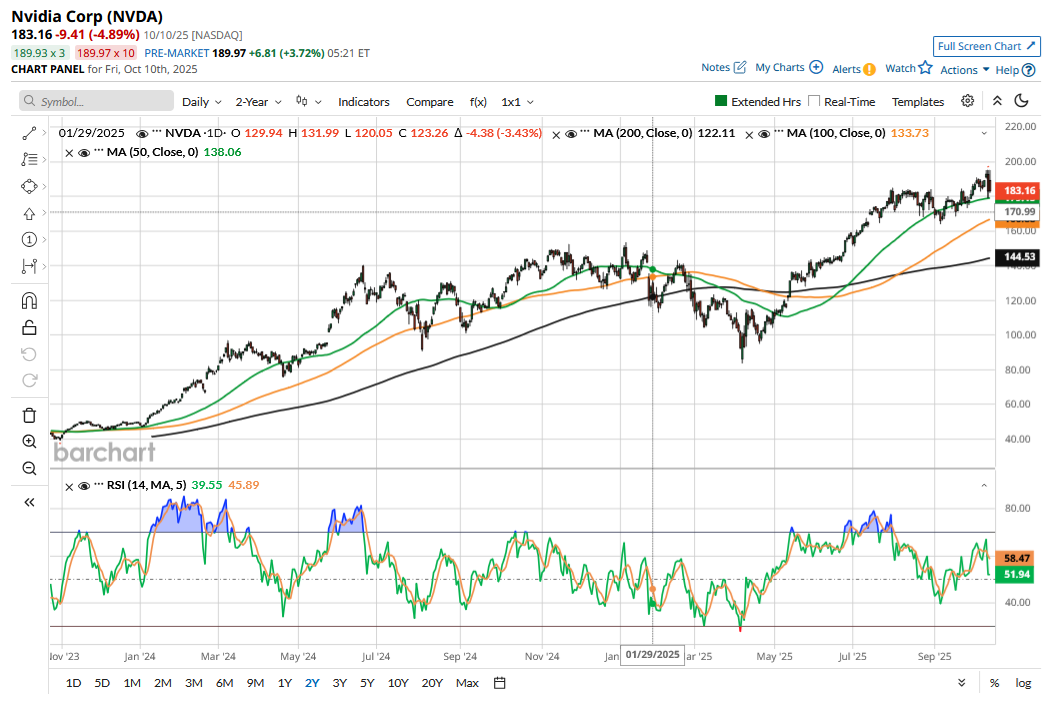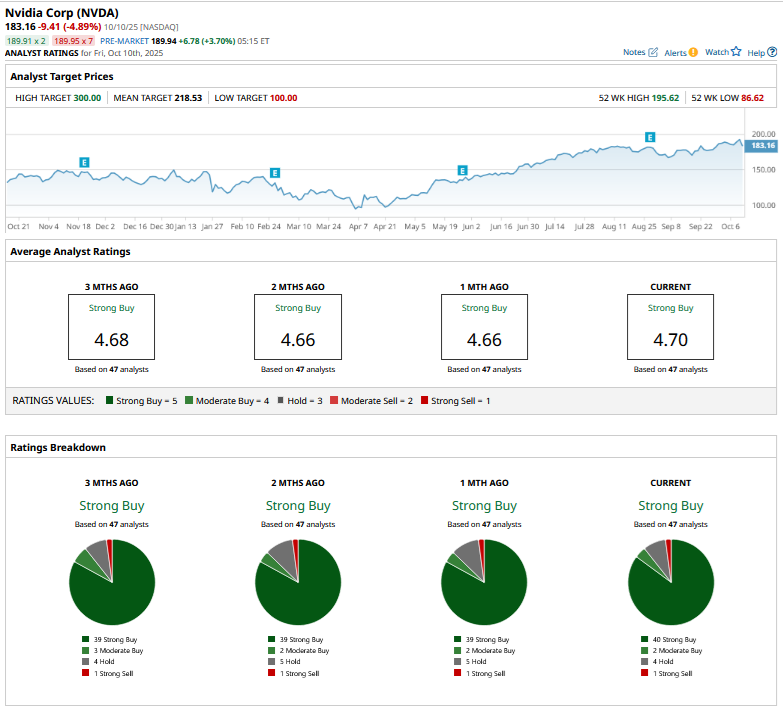- Market Overview
- Futures
- Options
- Custom Charts
- Spread Charts
- Market Heat Maps
- Historical Data
- Stocks
- Real-Time Markets
- Site Register
- Mobile Website
- Trading Calendar
- Futures 101
- Commodity Symbols
- Real-Time Quotes
- CME Resource Center
- Farmer's Almanac
- USDA Reports
Can NVDA Still Be a $300 Stock If Nvidia Loses Its Monopoly in AI GPUs?
/NVIDIA%20Corp%20video%20chip-by%20Antonio%20Bordunovi%20via%20iStock.jpg)
Nvidia (NVDA) has been the largest beneficiary of the artificial intelligence (AI) revolution, with its graphics processing units (GPUs) becoming the bedrock of the technology. The company has had a home run, controlling over 90% of the market for GPUs used in AI workloads.
It’s not that competitors haven’t tried challenging Nvidia’s dominance. From rival chip designers, Big Tech peers that also happen to be its customers, cash-rich startups, and Chinese tech companies, a lot of players have been trying to gain a foothold in the AI GPU market. While so far, none of these companies has managed a breakthrough that can rival Nvidia’s lead, things are moving quite fast. In this article, we’ll look at NVDA’s forecast amid signs that the company might lose its monopoly on the AI GPU market.

Who Is Threatening Nvidia’s Lead in the AI GPU Market?
Several players are trying to challenge the current status quo in the AI GPU market. The following are some of the developments that Nvidia investors should keep an eye on.
- Last week, Advanced Micro Devices (AMD) partnered with OpenAI, in a move which the former said would “deliver tens of billions of dollars in revenue.” While AMD is still a distant player in the AI GPU market, the deal is a sign that companies are looking to diversify their sourcing beyond Nvidia.
- Alibaba (BABA) is also working on AI chips and recently onboarded China Unicom as its first major external customer.
- Last month, Huawei came up with a three-year roadmap to challenge Nvidia. While Nvidia’s chips have an edge over the ones designed by Chinese companies, the country is trying to wean its tech companies away from Nvidia, and reports suggest that it has launched a customs crackdown on Nvidia’s AI chip imports. It would be foolhardy to dismiss the threat from Huawei, which even Jensen Huang believes will have “China covered” in light of U.S. export control restrictions.
- Hyperscalers, including Alphabet (GOOG) (GOOGL), Meta Platforms (META), Amazon (AMZN), and Microsoft (MSFT), that are ploughing billions of dollars into buying Nvidia chips, are also simultaneously working on custom chips to reduce or eliminate their reliance on Nvidia. Microsoft CTO Kevin Scott recently said that in the long term, the company plans to primarily use its own chips in data centers.
How Is Nvidia Protecting Its Turf in the AI Chip Market?
Meanwhile, Nvidia is also working to protect its turf in the AI chip market. First and foremost, it is doing what it has been doing nearly seamlessly for years, and is innovating to stay ahead of the competition. Last month, it unveiled the Vera Rubin NVL144 CPX platform, which will be a successor to the current Blackwell GPU. By staying a generation ahead of competition, Nvidia ensures that the demand for its chips stays red hot while enabling it to charge a premium price.
Secondly, the company has made strategic investments and announced an investment of up to $100 billion in OpenAI, $2 billion into Elon Musk’s xAI, and committed to invest 2 billion British pounds in AI startups in the U.K. While these investments have raised concerns over Nvidia basically buying revenue by investing in AI companies, since much of this money will flow back into its coffers as these companies buy Nvidia chips, it is a clever way of not only ensuring a continued revenue stream, but also gain from rising valuations of AI companies.
Can Nvidia Be a $300 Stock?
Last week, Cantor Fitzgerald analyst C.J. Muse raised Nvidia’s target price from $240 to a Street-high of $300. That target, which is significantly higher than the $218.53 that the average sell-side analyst believes Nvidia is worth, implies a market cap in excess of $7 trillion. While that valuation might seem astronomical, it’s a word that Nvidia investors have become used to, especially over the last 2.5 years.

All said, I believe the rally in Nvidia can continue, given the near unsatiable demand for AI chips, which continues to grow, and according to Huang, computing demand has risen “substantially” this year.
The AI infrastructure story is far from over, and Alibaba CEO Eddie Wu predicts that global investment in AI will reach $4 trillion over the next five years. On a similar note, Huang sees global AI infrastructure spending rising to between $3 trillion and $4 trillion by the end of this decade.
To sum it up, given the expected growth in AI infrastructure, there is a place for more companies in the AI GPU space. I remain bullish on Nvidia and have no intention of selling my shares despite the breathtaking rally, as the AI revolution looks set to continue for the time being, despite bubble fears.
On the date of publication, Mohit Oberoi had a position in: NVDA , BABA , META , MSFT , AMZN , GOOG . All information and data in this article is solely for informational purposes. For more information please view the Barchart Disclosure Policy here.